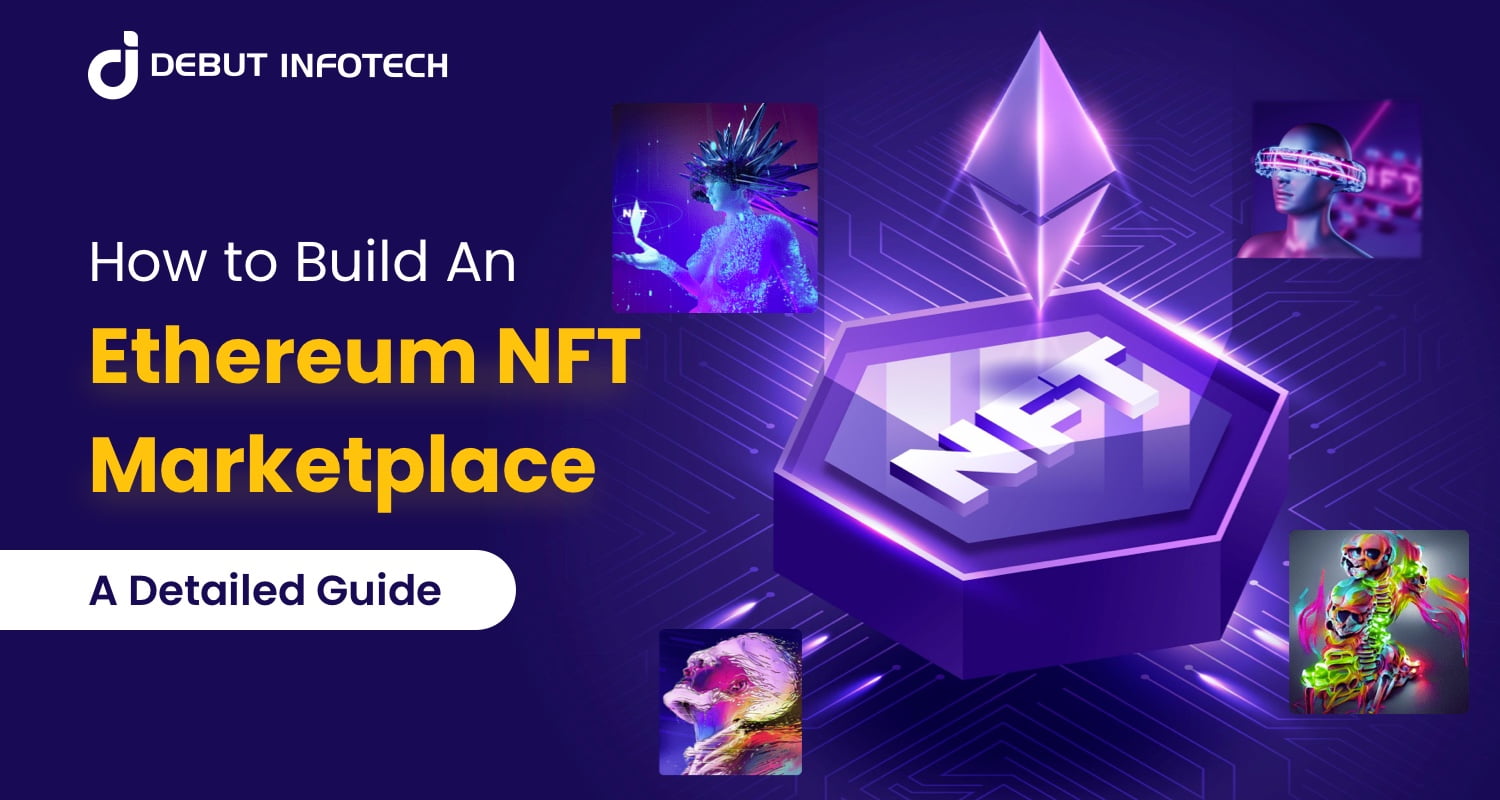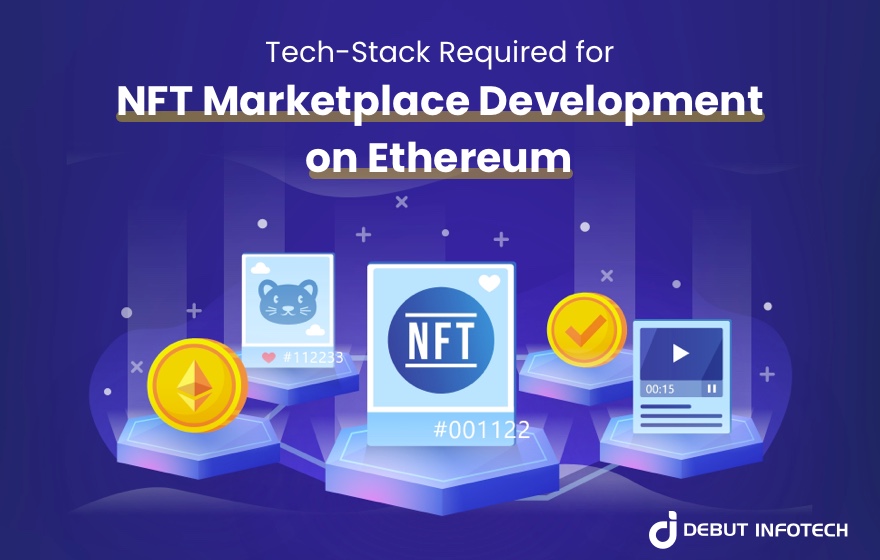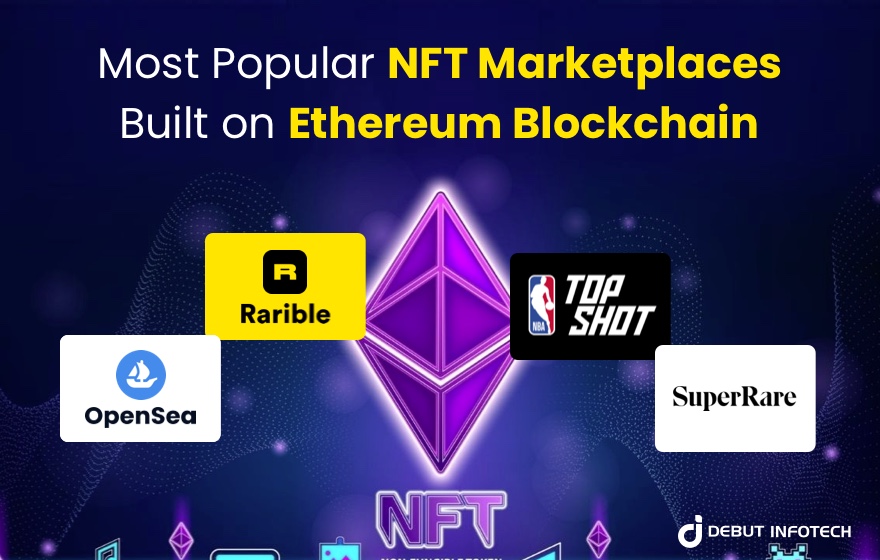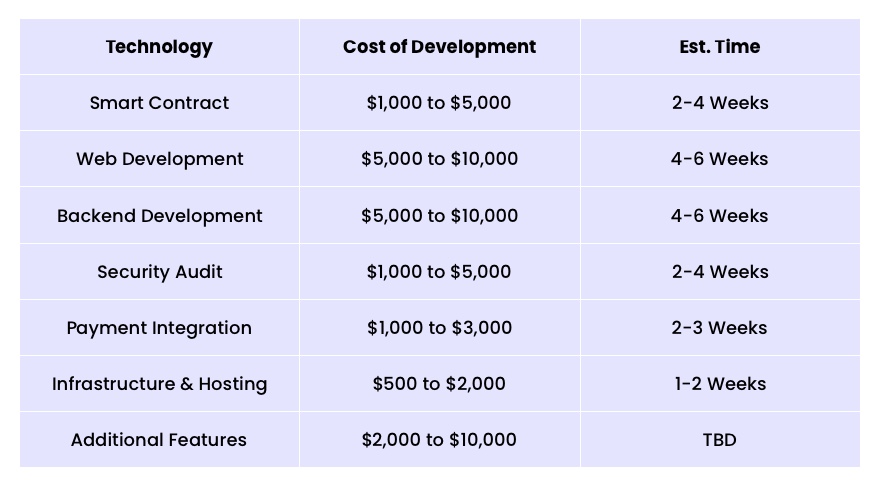Table of Contents
Home / Blog / NFT Marketplace
How to Build An Ethereum NFT Marketplace: A Detailed Guide
June 14, 2023

June 14, 2023
The surge in popularity of NFTs has presented entrepreneurs with a lucrative opportunity to build their own Ethereum NFT marketplace.
Recent reports suggest a potential rebound in the NFT market, as the value of non-fungible tokens on Ethereum exceeded $1 billion for the first time since May 2022.
Marketplaces such as OpenSea, Rarible, and SuperRare have emerged as thriving hubs for funding and substantial revenue. According to Statista, the NFT market revenue is projected to grow annually at a rate of 27.26% from 2022 to 2027, culminating in an estimated total of approximately $8,412 million by 2027.
This remarkable growth signifies the profitability of businesses associated with NFTs. Consequently, individuals, startups, and enterprises are now actively engaged in buying, selling, and investing in non-fungible tokens, driving the development of Ethereum NFT marketplaces.
However, before investing in an NFT marketplace on Ethereum, it is crucial to obtain a comprehensive understanding of Ethereum’s technology stack and ecosystem. This entails familiarity with programming languages such as Solidity and Vyper, development frameworks like Truffle and Embark, as well as infrastructure services like IPFS and Infura.
This article aims to provide readers with a thorough understanding of the factors associated with creating an NFT marketplace on the Ethereum blockchain, the requisite tech stack for building such a marketplace, the benefits derived from deploying an NFT marketplace on Ethereum, an overview of the most widely utilized NFT marketplaces already established on the Ethereum blockchain, and a step-by-step guide to building an NFT marketplace on Ethereum.
So, without further delay, let’s get underway with an overview of the Ethereum blockchain.
What is the Ethereum Blockchain?
Ethereum, a decentralized and open-source blockchain platform launched in 2015, provides developers with the means to construct decentralized applications (DApps) by utilizing smart contracts. These self-executing programs operate on the Ethereum blockchain and have gained recognition for their pivotal role in enabling decentralized finance applications and non-fungible tokens (NFTs).
At its core, Ethereum is a distributed ledger technology that facilitates secure and transparent transactions between parties, bypassing the need for intermediaries such as financial institutions. Operating on a proof-of-work (PoW) consensus mechanism, the Ethereum blockchain verifies and records transactions through a network of nodes that engage in computational tasks to solve complex cryptographic puzzles.
A prominent feature of the Ethereum blockchain is its ability to create and execute smart contracts. These programmable agreements are automatically triggered upon the fulfillment of predetermined conditions. By storing these contracts on the Ethereum blockchain, parties can engage in transactions without the involvement of intermediaries.
Furthermore, the Ethereum blockchain boasts the capability to generate and manage customized tokens, representing various assets or values, including cryptocurrencies, securities, and physical assets like real estate. ERC-20, a widely used standard on the Ethereum platform, outlines the fundamental functionality of tokens.
Alongside ERC-20 tokens, the Ethereum blockchain supports additional token standards, including ERC-721, specifically tailored for the creation of non-fungible tokens (NFTs). These unique digital assets authenticate ownership of specific items or content, such as artwork, music, or videos.
Ethereum serves as a potent and versatile platform, empowering developers to build a diverse array of decentralized applications and services. Its support for smart contracts and customizable tokens has facilitated groundbreaking applications across sectors such as finance, gaming, fashion, and art, cementing its role as a significant player in the blockchain and cryptocurrency industry.
Having considered the wide spectrum of information regarding the Ethereum blockchain & its range of features, let’s take a look at the process of tech-stack required for NFT Marketplace Development on Ethereum.
Tech-Stack Required for NFT Marketplace Development on Ethereum

The development of an NFT marketplace on the Ethereum blockchain necessitates a carefully selected technology stack to guarantee the platform’s security, efficiency, and user-friendliness. Below, we’ve outlined the essential components typically included in such a technology stack:
1. Programming Languages: Solidity and Vyper
These programming languages are commonly employed for smart contract development on Ethereum. Solidity is the most widely used language, offering a familiar syntax resembling JavaScript, while Vyper emphasizes security and simplicity.
2. Development Frameworks: Truffle and Embark
Truffle and Embark are popular development frameworks that simplify the creation, testing, and deployment of smart contracts on the Ethereum blockchain. They provide essential tools, libraries, and environments for efficient development workflows.
3. Infrastructure Services: IPFS and Infura
IPFS (InterPlanetary File System) is a decentralized and distributed file storage protocol that is often used to store NFT metadata and assets. Infura, on the other hand, is a widely adopted service that provides reliable and scalable access to the Ethereum network, allowing developers to interact with the blockchain without running their own nodes.
4. Wallet Integration: MetaMask
MetaMask is a browser extension that serves as a digital wallet, enabling users to manage their Ethereum accounts and interact with decentralized applications seamlessly. Integrating MetaMask into an NFT marketplace allows for secure transactions and seamless user experiences.
5. User Interface: React.js or Angular
Front-end frameworks like React.js or Angular are commonly utilized to build intuitive user interfaces for NFT marketplaces. These frameworks facilitate the development of responsive, interactive, and visually appealing interfaces that enhance the overall user experience.
6. Backend and Database: Node.js and MongoDB
Node.js is a JavaScript runtime environment that enables the development of scalable and efficient backend systems for handling server-side logic and API integrations in an NFT marketplace. MongoDB, a NoSQL database, is often chosen for its flexibility and scalability in managing large amounts of data.
7. Security and Auditing: OpenZeppelin
OpenZeppelin is a widely recognized framework for developing secure smart contracts on Ethereum. It provides a library of reusable and audited code that helps mitigate common security vulnerabilities, ensuring the robustness and integrity of the NFT marketplace.
8. Smart Contracts
Smart contracts play a pivotal role in automating the buying and selling process of NFTs within the marketplace. These self-executing programs, written in Solidity, Ethereum’s programming language, are stored on the Ethereum blockchain. By defining the regulations governing NFT transactions, ownership, and asset transfers, smart contracts facilitate seamless and efficient operations within the marketplace.
By carefully selecting and integrating these components into the technology stack, developers can establish a robust and well-rounded infrastructure for their NFT marketplace, catering to the security, efficiency, and user experience requirements of the platform.
Advantages of building an NFT marketplace on the Ethereum Blockchain
Building an NFT marketplace on the Ethereum platform offers a myriad of advantages, including decentralized architecture, robust security measures, and widespread accessibility. Delve into this comprehensive guide that outlines the compelling reasons to embark on building an NFT marketplace on Ethereum:
1. Decentralization
Ethereum’s decentralized nature ensures that the marketplace operates without reliance on a central authority. This empowers artists, collectors, and investors by fostering a transparent and open ecosystem.
2. Security Features
Ethereum’s blockchain technology provides robust security protocols, ensuring the integrity and immutability of NFT transactions. The distributed ledger enhances trust and mitigates the risk of fraud or unauthorized alterations.
3. Global Accessibility
Ethereum’s network spans the globe, enabling users from various geographic locations to participate in the marketplace. This global reach expands the potential user base and facilitates a diverse community of participants.
4. Standardization
Ethereum has established widely adopted standards for NFTs, such as ERC721 and ERC1155. Leveraging these standards ensures compatibility and interoperability with other platforms and applications in the Ethereum ecosystem.
5. Flexibility
Ethereum’s programmable smart contracts, implemented using languages like Solidity and Vyper, offer unparalleled flexibility in designing marketplace functionalities and features. Developers can customize the marketplace to meet specific requirements and incorporate innovative capabilities.
Most Popular NFT Marketplaces Built on Ethereum Blockchain

If you are considering the development of an Ethereum-based NFT marketplace, it is worthwhile to explore some of the popular and highly sought-after platforms available. These platforms can serve as valuable references and sources of inspiration for your custom NFT marketplace development project.
Here are a few of the current leading Ethereum-based NFT marketplaces that have garnered significant attention:
1. OpenSea like the NFT marketplace
OpenSea, established in 2017, holds a significant position in the NFT landscape, having facilitated the hosting of a wide range of popular NFTs such as art, music, photography, trading cards, and virtual worlds.
The primary cryptocurrencies utilized on OpenSea include Ethereum, Solana, Polygon, Avalanche, and BNB. While the platform supports various other cryptocurrencies as payment options, it is important to note that fiat currencies such as U.S. dollars or euros are not accepted.
One notable advantage of OpenSea is its user-friendly interface, catering well to beginners. Setting up an account is a swift and cost-free process, granting immediate access to browse NFTs. Additionally, OpenSea offers the convenience of creating NFTs directly on their platform.
Regarding costs, OpenSea charges a transaction fee equivalent to 2.5% for each transaction. Additionally, there may be supplementary fees associated with listing an item on Ethereum for the first time.
In summary, OpenSea presents a favorable choice for beginners seeking a straightforward marketplace. It provides an extensive array of options for NFTs while ensuring user-friendliness and ease of use.
2. Rarible like the NFT marketplace
Rarible offers a diverse range of options for buying and selling art, collectibles, video game assets, and NFTs. The platform supports transactions in multiple cryptocurrencies, including Ethereum, Polygon, Tezos, and Immutable X. However, it is important to note that it comes with a 1% transaction fee for both buyers and sellers.
An intriguing aspect of Rarible is its decentralized governance model. To avoid centralized decision-making, Rarible introduced its own native token called RARI. Holders of RARI have the privilege to participate in voting on important company matters, such as policy changes.
Notably, in 2021, Rarible announced a partnership with Adobe aimed at simplifying the verification and protection of metadata for digital content, including NFTs. This collaboration signifies Rarible’s commitment to enhancing the integrity and security of digital assets.
Rarible stands out as an attractive option for those seeking access to a large network with strong industry connections. Simultaneously, it adheres to the principles of decentralization, aligning with the ethos of the NFT ecosystem.
3. NBA Top Shot like NFT marketplace
For passionate basketball enthusiasts, the NBA Top Shot marketplace offers a captivating opportunity to acquire NFTs featuring remarkable moments from basketball history.
This unique platform enables users to purchase video clips, play highlights, and artwork encompassing both NBA and WNBA content. Notably, some of these Moments have commanded substantial prices, exemplified by a staggering $208,000 transaction for a LeBron James slam dunk video during the peak of the NFT market in February 2021.
The NBA, being the driving force behind the creation and management of this NFT marketplace, instills confidence by its status as a reputable and influential organization. Furthermore, the NBA retains exclusive rights to these coveted video clips, further establishing the legitimacy and authenticity of the offerings.
To facilitate transactions, users can acquire Moment NFTs using traditional payment methods such as credit or debit cards, as well as select cryptocurrencies including Bitcoin, Ethereum, Bitcoin Cash, DAI, or USDC. It is important to note that fees are applied to the purchase price, regardless of whether the buyer opts for a credit card or cryptocurrency payment.
Overall, the NBA Top Shot marketplace presents an enticing prospect for basketball enthusiasts, with its extensive collection of memorable moments and the assurance of engaging with a reputable organization.
4. SuperRare Like NFT Marketplace
SuperRare distinguishes itself as a premium NFT art marketplace, positioning itself as an art gallery within the NFT ecosystem. Notably, this platform adopts a discerning approach, carefully curating its collection and abstaining from accepting “meme style” NFTs, which lends an air of exclusivity.
The rigorous review process undertaken by SuperRare before making artwork available for sale instills confidence among investors, ensuring a higher level of quality and artistic merit. Consequently, individuals can have greater assurance in the caliber of artworks featured on the platform.
In terms of pricing, SuperRare applies a fee structure that includes a 15% charge for the first sale of an NFT on the primary market. Additionally, a flat transaction fee of 3% is levied, which the buyer assumes.
For those seeking high-end NFT artwork, particularly pieces with a more classical aesthetic, SuperRare represents an appealing option. Its commitment to maintaining artistic standards and providing a gallery-like experience makes it an attractive choice within the NFT landscape.
Steps to Build an NFT Marketplace on Ethereum
Building an NFT marketplace on Ethereum involves several steps, from designing the user interface to deploying smart contracts on the blockchain. Here is a detailed guide on how to develop an NFT marketplace on Ethereum:
Step 1 – Choose Your Business Model
To ensure revenue generation and maximize financial returns, it is crucial to consider diverse NFT business models and effective monetization practices. The following are the four prominent monetization strategies observed within the NFT marketplace segments:
1. Transaction Fees
Implementing transaction fees is a prevalent approach for generating revenue in NFT marketplaces. Charging a percentage fee on each transaction conducted within the marketplace allows platforms to accumulate revenue as users buy, sell, and trade NFTs.
2. Listing Fees
NFT marketplaces can introduce listing fees as a means of monetization. By charging creators a fee to list their NFTs on the platform, marketplaces can generate revenue while maintaining exclusivity and controlling the quality of the listings.
3. Value-Added Services
NFT marketplaces can offer value-added services to enhance revenue streams. These services may include premium features, exclusive partnerships, enhanced visibility for listings, or additional tools and analytics for creators. By providing unique and valuable services, marketplaces can attract users and charge fees for accessing these offerings.
4. Royalties
Royalties serve as a revenue stream for NFT marketplaces, wherein a percentage of subsequent sales of an NFT is automatically redirected back to the original creator or rights holder. This mechanism ensures ongoing revenue generation for creators as their NFTs are resold in the secondary market.
Implementing a combination of these monetization strategies can establish a sustainable revenue model for NFT marketplaces. Careful consideration should be given to market dynamics, user preferences, and the competitive landscape to determine the most effective blend of monetization practices for long-term financial success.
Step 2 – Select An Ideal Blockchain
The blockchain serves as the fundamental infrastructure of the best NFT marketplaces, playing a vital role in verifying NFT ownership and authenticity while facilitating seamless ownership transfers. Ethereum stands as the prevailing blockchain of choice for NFTs, yet alternative blockchains like Binance Smart Chain and Solana are witnessing increasing prominence within the NFT market.
When faced with the decision of selecting a blockchain, it is imperative to consider a range of factors, including transaction fees, network speed, security measures, and the extent of support from the developer community. The scalability of the chosen blockchain is paramount to ensure its ability to accommodate the anticipated growth of the marketplace.
Step 3 – Craft Your Marketplace Design
The success of your marketplace heavily relies on its design. A meticulously crafted marketplace should possess a visually captivating appearance, a user-friendly interface, and a range of features tailored to meet the needs of artists, collectors, and investors.
When devising the design of your marketplace, it is crucial to consider incorporating key features that enhance the user experience:
- Implement advanced search options and filters, enabling users to efficiently locate specific NFTs according to their preferences.
- Integrate analytics tools that provide users with valuable insights into NFT performance and market trends, facilitating informed decision-making.
- Establish a secure and transparent transaction process that capitalizes on blockchain technology to verify ownership and authenticate the NFTs, instilling trust among users.
- Develop an intuitive interface that simplifies the buying, selling, and trading of NFTs, ensuring a seamless experience for users across all levels of technological proficiency.
- Integrate a comprehensive rating system, empowering users to rate and review both NFTs and sellers, fostering a community-driven environment, and facilitating informed choices.
Furthermore, given the increasing prevalence of mobile device usage, it is imperative to prioritize mobile responsiveness in your marketplace design. This ensures that users can access and engage with your platform effortlessly, catering to their evolving preferences and habits.
By meticulously considering and incorporating these design elements, your marketplace will be poised to attract and retain a diverse user base, propelling its success in the dynamic NFT landscape.
Step 4 – Define the Architecture of Smart Contracts
Smart contracts on the Ethereum blockchain are autonomous programs that execute actions and handle NFT creation and management. These contracts adhere to established standards like ERC721 and ERC1155 specifically designed for NFTs.
Renowned frameworks such as OpenZeppelin or Truffle facilitate the creation, testing, and deployment of smart contracts. Define the structure, functions, and event triggers of the contracts according to your marketplace’s specific needs.
Step 5 – Smart Contract Development Process
After finalizing the smart contract architecture, it is time to proceed with the development phase. Begin by implementing the necessary functions to facilitate the creation, purchase, sale, and transfer of NFTs, along with incorporating pricing mechanisms, royalty structures, and other marketplace regulations.
Before deploying the smart contracts on the Ethereum mainnet, it is advisable to utilize test networks like Ropsten or Rinkeby for thorough testing and validation.
Step 6 – Legal Compliance
Safeguarding legal compliance is crucial for the enduring prosperity of your NFT marketplace. The regulatory environment surrounding NFTs is dynamic, necessitating continuous vigilance and keeping abreast of the latest laws and regulations to evade legal complications and potential penalties.
Consider the following pivotal legal considerations:
1. Intellectual Property Rights
Take measures to ensure that NFTs listed on your marketplace do not infringe upon copyrights, trademarks, or any other intellectual property rights.
2. Taxation
Depending on your jurisdiction, it may be mandatory to collect and remit taxes associated with NFT transactions.
3. Anti-money Laundering (AML) and Know Your Customer (KYC) Regulations
In certain jurisdictions, adherence to AML and KYC regulations may be obligatory for NFT marketplaces to mitigate the risks of money laundering and fraudulent activities.
To navigate these legal intricacies proficiently, it is imperative to engage the services of experienced legal professionals who can provide guidance and ensure that your marketplace complies with all applicable laws and regulations.
By following these meticulous steps, enterprises can embark on the development journey of an Ethereum-based NFT marketplace.
What is the Cost to Build An NFT Marketplace on Ethereum Blockchain? (Estimated Cost & Time)
Establishing an Ethereum NFT marketplace necessitates careful consideration of diverse components and factors, each impacting the comprehensive NFT Marketplace development cost structure. Crafting such a platform entails assessing an array of elements and variables, requiring a meticulous approach to ensure optimal financial allocation and resource utilization.

Here in this image, while providing rough approximations, it is crucial to acknowledge that the actual costs & time associated with the project can fluctuate, influenced by your unique specifications, the selected development team, and prevailing market rates. Variations in these factors necessitate prudent evaluation to derive accurate estimations and effectively manage financial expectations.
Let Debut Infotech Assist You Build An Ethereum-integrated NFT Marketplace
Developing an NFT marketplace on the Ethereum blockchain can be a highly rewarding endeavor for entrepreneurs, developers, and crypto enthusiasts alike. Ethereum’s decentralized architecture, robust security features, global accessibility, standardization, and adaptability make it an optimal platform for hosting NFTs and constructing innovative marketplaces.
By harnessing the technological capabilities offered by Ethereum, which include programming languages like Solidity and Vyper, development frameworks such as Truffle and Embark, and infrastructure services like IPFS and Infura, one can create a scalable and resilient marketplace for NFTs that can attract a diverse user base encompassing collectors, investors, artists, and gamers.
Nevertheless, the process of building an NFT marketplace on Ethereum requires meticulous planning, development, and testing, in addition to compliance with regulatory requirements and community norms. It is imperative to consider various factors including user experience, security measures, token economics, revenue models, and governance, among others, when embarking on the development of an NFT marketplace on Ethereum.
For those interested in venturing into the development of an NFT marketplace on Ethereum, Debut Infotech is a reputable blockchain development company specializing in NFT marketplace development, leveraging its extensive knowledge and experience in decentralized solutions. Our team comprises experts well-versed in NFT marketplaces, capable of transforming your idea into a highly profitable venture through our custom NFT marketplace development expertise.
With a deep understanding of the NFT landscape, we have successfully developed business models and marketplaces in this domain. We provide you with the flexibility of choosing between two options: constructing a bespoke NFT marketplace or leveraging the OpenSea SDK for development. Additionally, we offer support in creating brand-specific NFTs, thereby enhancing your revenue streams.
Whatever your Ethereum NFT marketplace idea may be, you can reach out to our experts and get a free 30-minute personalized consultation session.
Talk With Our Expert
Our Latest Insights
USA
2102 Linden LN, Palatine, IL 60067
+1-708-515-4004
info@debutinfotech.com
UK
Debut Infotech Pvt Ltd
7 Pound Close, Yarnton, Oxfordshire, OX51QG
+44-770-304-0079
info@debutinfotech.com
Canada
Debut Infotech Pvt Ltd
326 Parkvale Drive, Kitchener, ON N2R1Y7
+1-708-515-4004
info@debutinfotech.com
INDIA
Debut Infotech Pvt Ltd
Sector 101-A, Plot No: I-42, IT City Rd, JLPL Industrial Area, Mohali, PB 140306
9888402396
info@debutinfotech.com




Leave a Comment